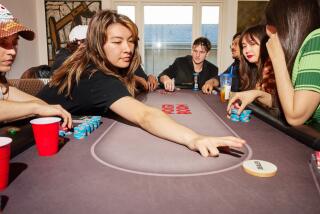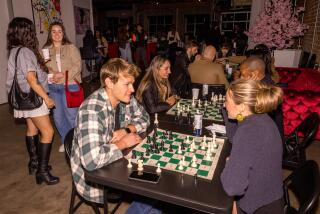Table Tennis Fever Spreading Quickly at Orange Coast College : Local Club Has 260 Members, Making It the Largest, Finest Group in Southern California
- Share via
About five years ago, Terry Timmins caught a fever he hasn’t been able to shake. He has fed it religiously, but it just seems to grow hotter.
Timmins, 46, has table tennis fever.
When he doesn’t play the sport for a week, he says he has withdrawal pangs.
“If you start gravitating and turning your car to one of the 25 table tennis clubs in Southern California when you know you should be doing something else like going to work, or studying, then you’ve got the fever,” Timmins said.
“If it’s beginning to affect your home life, and your boyfriend or girlfriend is beginning to question your mental stability, then you’ve got the fever.”
Five years ago, the fever led him and Joe Tran, a native of Vietnam, to start the Orange Coast College Table Tennis Club in Costa Mesa. The club has grown into the largest and, it is generally regarded, finest table tennis group in Southern California.
Timmins, an OCC associate professor of sociology and anthropology from Laguna Beach, used to play table tennis in a class at OCC. He said Orange Coast is the only college in California that teaches table tennis as an accredited subject.
“We used to play during lunch time in the patio between the cafeteria and the administration building outdoors in the sunlight and rain with wind and fog and leaves falling . . . we didn’t care, it was fun,” Timmins said.
Timmins, Tran and others decided they wanted additional playing and practice time. Timmins offered to be faculty adviser so the club could get access to the gymnasium. The group raised $500 through memberships and, with matching funds from the Associated Students, purchased five used tables from a club in San Diego.
Through tournaments and membership fees, the club has been able to purchase 24 championship tables worth nearly $20,000.
Timmins, who remains the club’s adviser, is still feeding his fever. He spends about 25-30 hours a week playing, organizing tournaments, teaching classes, giving lessons or driving to other clubs to practice.
About 260 belong to the Orange Coast club, with players coming from Riverside, Los Angeles and San Diego counties.
The club members are playing a highly competitive and demanding sport that is not to be confused with Ping-Pong that’s played in basements and back yards.
“Table tennis is when the ball goes over 100 miles per hour and spins over 100 times per second--more than the blades of a 747 jet engine,” Timmins said.
It is the fastest racket sport in the world, said Timmins, who is very protective of the sport.
“I don’t want to get into a battle with these other sports,” he said, “ but . . . in table tennis the playing surface is nine feet long and the ball travels in excess of 130 miles an hour when hit by a world-class player and over 100 miles per hour when hit by even your average good player.
“The relative sizes of the court in badminton, table tennis and tennis are significant. You may be only 10 feet away from your opponent and the ball could be coming at you at over 100 miles an hour and you have to react, so how is badminton going to be faster than table tennis?”
Though many Americans play the sport, only about 6,000 are registered members of the United States Table Tennis Assn., said Scott Mathews, the acting executive director of the United States Table Tennis Assn., the governing body for the sport in this country.
By comparison, China has about 40 million players.
In this country, the sport has an image problem, according to Timmins, because it has similarities to Ping-Pong. But table tennis is a much more advanced and physically intense sport.
“People see it as a lightweight sport where you are just pushing a little white ball back and forth across a little table and any old lady can do it,” Timmins said.
In the U.S., table tennis takes a back seat to more established sports.
In Europe and Asia, it’s taught in elementary schools or at government subsidized sports academies. Professional table tennis players can make a living in China and championship competition regularly draws crowds of 1,000 or more.
International table tennis, which was a demonstration sport in the 1984 Olympics and became a medal sport for the ’88 Games, is popular with children and the elderly because players don’t need to be big or strong. They just need good hand-eye coordination, Timmins said.
And the Orange Coast club has players of all ages, from 12-year old Wang Ling to 75-year-old Bob Davies.
Ron Whitlock, a 6-foot, 240-pound Orange Police detective, dispels the myth that table tennis is a game for lightweights.
He attended college on a football scholarship and says people expect him to be a boxer or a weightlifter. But he enjoys table tennis for its spontaneity.
He has represented the police department in various tournaments and has competed in Australia, Bermuda and Canada.
Almost every Friday from 6 to 10 p.m. and every Sunday from 2 to 6 p.m. (the club’s hours of play), Whitlock, 44, holds down a table, routinely sweating through three or four shirts a session.
“There is a finesse in chess where one could be a quadraplegic or a giant and play the game well,” Whitlock said. “People don’t equate the finesse to table tennis that there truly is and, it is that finesse that makes me keep coming back.”
“It’s a physical and mental sport . . . a combination of which I haven’t found in any other sport and I have played a lot--rugby, Australian rules rugby, football, baseball, soccer. Each in its own respect offers someone a very great deal, but table tennis offers an ultimate combination of thought and action, a link that does not exist in any other sport, an intimacy between the mind and body not offered anywhere else.”
Lenny Hauer, who drives from his home in Laguna Niguel to Costa Mesa to play at the club because “that is where the best players play,” calls table tennis the “essence of athletic activity.
“It goes so fast . . . it seems a challenge because there are so many things that need to be done in such a short time. You have to adjust the direction you hit every ball based upon differing spins and that decision has to be made in your hand, not your head.”
Hauer honed his skills at the U.S. Olympic Training Center in Colorado Springs, Colo., in 1985 as a tutor of sorts overseeing the education of America’s top juniors.
The game is not the only thing that keeps players driving long distances to meet and compete. Friendships develop.
Whitlock made friends with a couple in Australia and they have visited each other’s homes.
“I am going to Vancouver, British Columbia, to play in the World Police and Fire Games with police officers and firemen throughout the world,” he said. “I am looking forward to competing against my first Soviet athletes. Hong Kong is coming. Japan is coming.
“We’ll compete talk, discuss, be nice. That’s really what it’s about. That’s really the way to solve problems.”
Said Timmins: “It is an international game so we have a lot of foreign students and players. You name it, we’ve got it. We have every nationality in the world play here--Iranians, people from the Middle East, people from the Caribbean Islands, Asians representing all Asian countries: Cambodia, Laos, Vietnam, China, Japan, Taiwan.
“We cross political barriers. Ping-Pong is the most melting pot sport there is. It doesn’t matter if you’re from Taiwan, or mainland China. All (the players) do is talk table tennis. It is an addiction, it is a sickness, it is a fever, it breaks marriages up and it makes marriages.”
Diego Schaaf, 36, a club member who grew up in Switzerland, did not play seriously until he came the United States in 1983.
His game has improved even more in the past year since he began playing at the Orange Coast club with Wei Wang, the nation’s fourth-ranked female player. The two married in March.
Schaaf said that as a beginner he had no concept of the crucial factors--spin, footwork, ball placement--that distinguish the game of Ping-Pong, from the sport of table tennis. At its higher levels, the sport requires quick reflexes, fast feet, good hand-eye coordination and patience.
“Before I started playing, I had a completely different life,” Schaaf said. “Ever since I started playing, I have played almost every day. I guess you would call that infected. A lot of people are that way. They go and play. When they start understanding the depth, how much there is to it, it becomes so intriguing, you just want to play every day.”
It’s not hard to learn the sport, said Joe Tran, one of the club’s founders and currently its president. But it takes about two years to learn how to hit and return all the strokes.
The key is reading the spin on the ball. Players use a variety of arm motions to send the ball over the net with top spin, side spin, under spin or no spin.
The different styles of hitting the ball are known as looping, chopping, spinning and killing.
Southern California is one of the best places to learn because it is one of the two strongest table tennis areas in the nation. The corridor from Boston to Washington is first, Mathews of the USTTA said.
There are about 300 clubs in the United States. The U.S. men’s team ranks only 20th internationally and the women’s 12th, primarily because the sport is not a part of the elementary school system.
But the USTTA is trying to change that, Mathews said. Table tennis has become part of school curricula in Portland, Ore., Baltimore and Colorado Springs.
And the USTTA has teamed with the Boys Club of America to introduce the sport at the organization’s several hundred clubs nationwide.
“That is our biggest source of juniors,” Mathews said. “These kids happen to be very young and we want to introduce them at a young age and follow the European model.”
More to Read
Sign up for Essential California
The most important California stories and recommendations in your inbox every morning.
You may occasionally receive promotional content from the Los Angeles Times.









